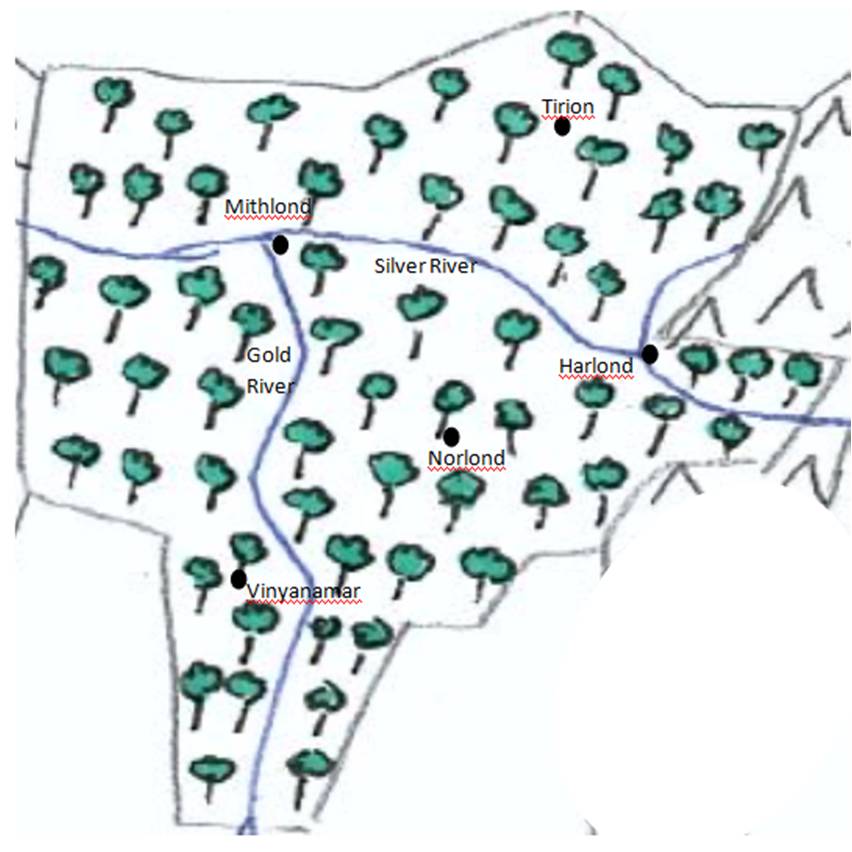The Great Forest (Existence Supplement)
| Existence's Contents |
|---|
| Information for Everyone |
| World Information |
| Information for the DM |
The Basics[edit]
The Great Forest, like the Wasteland, sprang into existence when Zora attempted what became known as the Great Purge. Unlike the nation of Arya, which was taken completely by surprise, the Nortilian Empire had enough warning and sufficiently powerful mages to divert the damage of the purge. Unable to stop the destructive magic outright, they were able to rechannel it into the creation of a massive forest, instead of a vast wasteland that was intended. Most of the inhabitants died, the remaining were forever changed from humans to elves - and thus the first elf came into being. The Great Forest now lies between the Triporia and Meroria mountain ranges, south of Belgoria and Tilia and north of Aarlan. Until the Great War of the southern continent, when adjacent nations started to do massive logging in the Great Forest, it had expanded nearly to the Inner Sea and well into the mountain borders.
Unlike all other true nations, the Great Forest elves have five major cities and no capitol. Instead, the city of Mithlond acts as a central point at which the different tribes gather to trade, and to discuss events concerning the elven nation. Tirion controls all of the Great Forest north of the Silver River, while Vinyanamar controls it to the south and west of the Gold River. Norlond controls the forest east of the Gold River and south of the Silver River; while Harlond controls the smallest portion of the forest, east of the Silver River’s split.
The cities and villages of the elven people are quite different than elsewhere in the world. Instead of buildings made of earth and cut wood, all of the buildings are made of living wood. The greatest buildings, such as the city centers and main trade centers, are all built into the trees themselves, while dwellings and lesser buildings are simply built spanning the treetops. Few, if any, buildings ever touch the ground, making defense easier.
Beliefs[edit]
The Great Forest has its own pantheon, and as only elves are allowed to live within the bounds of the forest, no other gods are followed.
Race & Gender[edit]
Elves are the only race allowed to live within the Great Forest borders. Some humans, dwarves, catfolk and other races enter the forest to trade; they are limited to staying along the rivers and never going inland.
Women and men are considered equals, and each tribe is led by a king or queen (depending on the tribe).
Current Affairs[edit]
Though tensions are always high between the elves and the other adjacent nations, due to recent events it looks as though war may be about to break out again. The queen, her daughter and her sister were captured from the city of Tirion while on a mission to Mithlond to discuss a trade agreement. When the elves found out that the captives were being used as little more than brood mares, their anger burst into rage and many raiding parties have crossed the border. War is the watchword, and all tribes seem eager to once again bring retribution upon their Belgorian neighbors.
After the Great War, the elves had made peace with the nation of Aarlan and offered to them a princess to be their new king's wife, since their previous king had just been assassinated by an elf. Agreeing, this marriage produced a daughter after only a year and a son only five years afterwards. The queen is again pregnant with their fifth child, though the treaty had only required one, indicating that the couple might have actually fallen in love. If this is the case, the peace between the two nations is likely to become stronger with time. The kidnapping of their eldest son has been seen as an affront to the elven nation, as well as the Aarlans, and is another log added to the fire of war against Belgoria.
Classes[edit]
Common Classes[edit]
• Barbarian: The elves of the great forest are very tribal in nature, and though four cities rule over the forest as a whole, many minor tribes still exist - some of which are extremely primitive. It is hardly unheard of for warriors of these tribes to charge into battle in madness, wearing nothing but war paint - both man and woman alike.
• Bard: With so many primitive tribes, the traditions of the elves must be passed down orally. Great epic songs, sometimes lasting for days on end, are favored at the courts - and especially in Mithlond, prior to a meeting of the Kings and Queens. A skilled bard is treated almost as nobility in all other lands.
• Druid: Being close to nature is at the very heart of the elven mentality, and so druids are extremely common. Many druids are leaders of the faith, taking on the role of clergy while also doing all they can to protect their homeland - much like a paladin would.
• Ranger: The thick forest allows for many unwanted guests to arrive unseen, and these guests prove to be incredibly dangerous. With so many primitive tribes, rangers are needed to protect them from threats like the Belgorian slave raiders.
Rare Classes[edit]
• Cavalier: The thick woodlands of the forest are not at all suitable for mounted warfare, and although a few dare try their hand at it, not many have any success. Still, some elves believe mounted warfare is important to master, especially if an attack upon the more open lands of Belgoria is brewing.
• Cleric/Inquisitor/Paladin: These roles are mostly filled by the druids.
Back to Main Page → 3.5e Homebrew → Campaign Settings → Existence Campaign Setting
